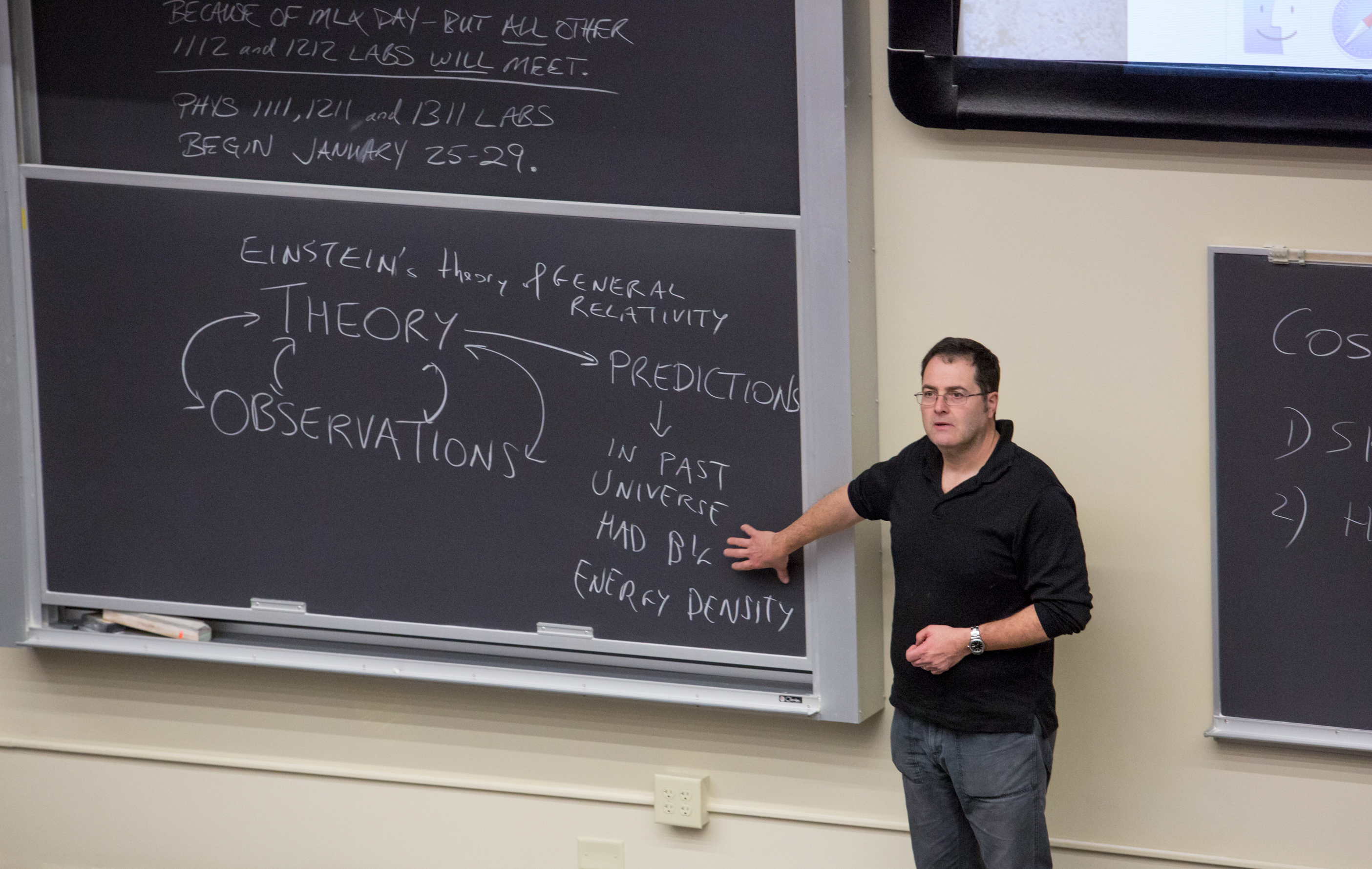Science Café: Getting a Bang out of Science
By: Cynthia Adams | Photos By: Nancy Evelyn
A group of wide-ranging ages and backgrounds packed a campus auditorium on an inclement winter night this past February—to the delight of Science Café organizers and volunteers. The anticipated night-sky viewing with telescopes had to be cancelled due to the rains, but it did not dampen the enthused crowd who turned out.
The mixed group of townspeople gathered to hear a physicist, Loris Magnani, speaking on the subject of cosmology, the Big Bang theory, and the origins of the universe. Parents filed into a large room bringing young children, comprising an audience total of nearly 150 people. The parents settled in beside the middle-aged and collegeaged—a healthy mix of men and women of all ages equally eager to hear how, as Magnani explained, “The Big Bang theory is a model of how the universe works.”
SCORE ONE FOR SCIENCE!
The Big Bang Theory is premised upon a rapid series of extraordinary events (or, perhaps events that happen to be ordinary, according to some theorists) occurring nearly 14 billion years ago. (See The Big Bang Theory in Brief.)
Magnani, casually dressed in black, wrote Cosmology, Study of the Universe upon an old-fashioned blackboard. The audience leaned in attentively.
“Talking about the origins of the universe in 30 minutes is kind of ludicrous,” he began. “But at least it will give you an idea of the famous Big Bang theory.”
And that was just the kick-off for Magnani. There was a sensation of IQs being boosted, simply by association, as a physicist chats and scribbles diagrams about the cosmos. He highlighted brainteasing theories relative to the origin and nature of the cosmos. The question you should ask, he suggested, is a salient one: “Does this theory lead to predictions that I can use?”
Magnani helpfully drew an illustration of theory, predictions and observations, explaining how cosmology is the branch of astronomy that deals with the universe as a whole. He cited Olbers’ paradox, which was named after the German astronomer Heinrich Wilhelm Olbers. Olbers’ paradox is also called the “dark night sky paradox.” What is paradoxical about a darkened sky? Simply put, an infinite, static universe containing an infinite number of stars would suggest every line of sight would end in a star, creating a much brighter night sky. (And, physicists say, when the cosmos was younger the night sky was formerly far brighter.)
Magnani said, “When you look at galaxies/night sky, there are only two stars. Everything else is a distant galaxy; the stars in our galaxy are in our neighborhood. The farther away a galaxy is, the faster it is moving away from you. What is that telling us about the universe?”
Theorists began scrambling to formulate explanations. A theory sitting there, Magnani explained, was Einstein’s Theory of General Relativity, the most general theory of motion. And then, he added, American astronomer Edwin Hubble discovered the universe is not static, and that everything is moving.
“For a theory to be a good theory it must make predictions; these two theories establish that the universe is expanding.”
As the universe expands it dilutes, Magnani added, with the dispersion of energy. “In the past, the universe had bigger energy density; it was hotter. And as it expands it gets cooler.”
In 1964, two radio astronomers, Arno Penzias and Robert Woodrow Wilson, were working for Bell Labs, in one of the world’s largest radio astronomy departments. Penzias and Wilson discovered a “hiss” coming from outside our galaxy. Astronomers at Princeton (only 37 miles away) working on background radiation explained to the team what the hiss actually was.
“It was cosmic microwave background radiation. For their work,Penzias and Wilson won a Nobel Prize,” Magnani said. “Once cosmic radiation was found, the Big Bang Theory stood because it was the only predictor,” he explained.
Radiation—the source of the hiss—diluted and dispersed as the universe cooled down. The establishment of cosmic microwave background radiation was a breakthrough substantiating the Big Bang Theory. The Big Bang Theory itself has since expanded as well, with more knowledge unfolding into the present.
“Since then, there were two momentous discoveries,” Magnani added. The first is this: “Most of the matter in the universe is dark matter.” The name is misleading, he explained. “The ‘dark’ part says it doesn’t react with light at all. And, secondly, dark matter does not interact with normal matter. You infer this through gravity; we’re 99 percent convinced dark matter is out there.”

Lars Magnani presenting at Science cafe.
As for dark matter, Magnani says “In a very profound sense we don’t know much about it. But we are convinced it is there…a big change in the structure of the universe. The majority of matter you cannot see in the normal way.”
For the record, dark energy has nothing to do with dark matter, he explained. “It is a repulsive gravity. Dark energy pushes things apart. Dark energy doesn’t fit into the Big Bang Theory.” (Magnani further explained that “You have to allow for dark matter. Einstein included a ‘fudge factor’ called the cosmological constant, which did that.”)
And yet, dark energy remains a scientific conundrum. “There are no theories that explain dark energy and why this profound mystery is pushing things apart,” he added.
An audience member asked, “If everything is moving away from us, we must be the center of everything?”
“No,” answered Magnani.
Using the metaphor of the universe as a fabric that gives and expands, he explained that there is no center. He referenced Hoyle’s relativistic theory, which states that dark matter expands the universe. He discussed spiral galaxies and the spinning of matter—moving much faster than it should according to preexisting ideas about gravitational laws.
“Dark matter, or ‘weird, exotic particles’ like neutrinos, don’t have an electromagnetic interaction.”
So, how is dark matter distributed? Magnani offered a visual.
“Think of a big, spiral galaxy.” (Galaxies formed, he says, where there is dark matter in the universe.) “Particle physics called it ‘inflation’. Like the Big Bang Theory from the 1980s, inflation is kind of a patch.”
The mysteries of the universe had to pause long after the half hour ended. Magnani remained afterward at the center of a crowd—answering enthusiastic question after question. He had touched something of profound meaning. As the audience exited into the night, stars were absent in the swirl of mist and fog. The sky was appropriately dark.
The deepening universal mystery of everything would continue.

The phases of the Big Bang Theory
For Further Research:
UGA Origins Lecture Series
“Origin of the Universe,” by Loris Magnani | www.youtube.com/watch?v=b1B-jerDhnQ
NASA “Ask an Astrophysicist” | www.imagine.gsfc.nasa.gov/ask_an_astronomer.html








